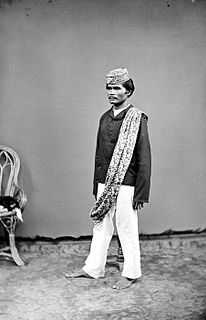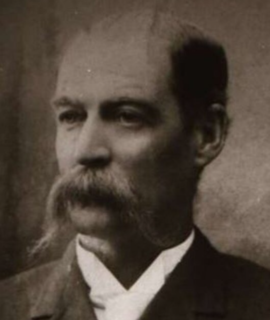
Groote Eylandt is the largest island in the Gulf of Carpentaria and the fourth largest island in Australia. It was named by the explorer Abel Tasman in 1644 and is Dutch for "Large Island" in archaic spelling. The modern Dutch spelling is Groot Eiland.

The Boyd massacre occurred in December 1809 when Māori residents of Whangaroa Harbour in northern New Zealand killed and cannibalized between 66 and 70 Europeans. This is reputedly the highest number of Europeans killed by Māori in a single event in New Zealand. The massacre is thought to have been in revenge for the whipping of a young Māori chief by the crew of the sailing ship Boyd.

Arnhem Land is a historical region of the Northern Territory of Australia, with the term still in use today. It is located in the north-eastern corner of the territory and is around 500 km (310 mi) from the territory capital, Darwin. In 1623, Dutch East India Company captain Willem Joosten van Colster sailed into the Gulf of Carpentaria and Cape Arnhem is named after his ship, the Arnhem, which itself was named after the city of Arnhem in the Netherlands.

Public holidays in Malaysia are regulated at both federal and state levels, mainly based on a list of federal holidays observed nationwide plus a few additional holidays observed by each individual state and federal territory. The public holidays are a mix of secular holidays celebrating the nation and its history, and selected traditional holidays of the various ethnic and religious groups that make up the country.

The Yolngu or Yolŋu are an aggregation of Aboriginal Australian people inhabiting north-eastern Arnhem Land in the Northern Territory of Australia. Yolngu means "person" in the Yolŋu languages. The terms Murngin, Wulamba, Yalnumata, Murrgin and Yulangor were formerly used by some anthropologists for the Yolngu.
The Gove Peninsula is at the northeastern corner of Arnhem Land in the Northern Territory of Australia. The peninsula became strategically important during World War II when a Royal Australian Air Force base was constructed at what is now Gove Airport. The peninsula was involved in a famous court case known as the Gove land rights case, when local Yolngu people tried to claim native title over their traditional lands in 1971, after the Australian Government had granted a mineral lease to a bauxite mining company without consulting the local peoples. Today the land is owned by the Yolngu people.

Makassar people from the region of Sulawesi in Indonesia began visiting the coast of northern Australia sometime around the middle of the 18th century, first in the Kimberley region, and some decades later in Arnhem Land. They were men who collected and processed trepang, a marine invertebrate prized for its culinary value generally and for its supposed medicinal properties in Chinese markets. The term Makassan is generally used to apply to all the trepangers who came to Australia.

Nhulunbuy is a township that is the sixth largest population centre in the Northern Territory of Australia. Nhulunbuy was created on the Gove Peninsula in north-east Arnhem Land when a bauxite mine and a deep water port were established in the late 1960s, followed by an alumina refinery.
The Caledon Bay crisis, refers to a series of killings at Caledon Bay in the Northern Territory of Australia during 1932–34, referred to in the press of the day as Caledon Bay murder(s). Five Japanese trepang fishers were killed by Aboriginal Australians of the Yolngu people. A police officer investigating the deaths, Albert McColl, was subsequently killed. Shortly afterwards, two white men went missing on Woodah Island. With some of the white community alarmed by these events, a punitive expedition was proposed by Northern Territory Police to "teach the blacks a lesson".

The history of Darwin details the city's growth from a fledgling settlement into a thriving colonial capital and finally a modern city.

Anindilyakwa is an Australian Aboriginal language spoken by the Anindilyakwa people on Groote Eylandt and Bickerton Island in the Gulf of Carpentaria in the Northern Territory of Australia. Anindilyakwa is a multiple-classifying prefixing language in which all traditional nouns, adjectives, personal and demonstrative pronouns are prefixed for person, number and gender. According to the 2016 Australian Census, Anindilyakwa was spoken natively by 1,486 people, an increase from 1,283 in 2006.

Australian frontier wars is a term applied by some historians to describe violent conflicts between Indigenous Australians and non-Indigenous settlers during Australia's mass immigration period. The first fighting took place several months after the landing of the First Fleet in January 1788, and the last clashes occurred into the early 20th century, with some occuring as late as 1934. An estimated minimum of 40,000 Indigenous Australians and between 2,000 and 2,500 settlers died in the clashes. Clashes occurred in a number of locations across Australia.

The Makassar or Makassarese people are an ethnic group that inhabits the southern part of the South Peninsula, Sulawesi in Indonesia. They live around Makassar, the capital city of the province of South Sulawesi, as well as the Konjo highlands, the coastal areas, and the Selayar and Spermonde islands. They speak Makassarese, which is closely related to Buginese and also a Malay creole called Makassar Malay.

Pobasso, also spelt Probasso or Pobassoo, was the chief of a division of the Makassan fleet of perahu in the waters between northern Australia and Indonesia in the late 1700s and early 1800s. The fleet harvested trepang, or sea cucumber, trading it to China. Pobasso was a key informant on the early Makassan relationships with Australia's Indigenous peoples prior to European settlement.

Wurrwurrwuy stone arrangements is a heritage-listed indigenous site at Yirrkala, Northern Territory, Australia. It is also known as Wurrwurrwuy. It was added to the Northern Territory Heritage Register on 15 August 2007 and to the Australian National Heritage List on 9 August 2013.
Wonggu Mununggurr (c.1880–1959) was an Aboriginal Australian artist and leader of the Djapu clan of the Yolngu people of northeast Arnhem Land in the Northern Territory of Australia.

John "Jack" Watson was a frontier cattle station manager and drover in the British colony of Queensland and in the Northern Territory. He was renowned for his fearless behaviour and also his sadistic brutality toward Indigenous Australians. He was called "The Gulf Hero" due to much of his fame being achieved while working on pastoral properties located in the Gulf Country.
Umbakumba is a community located on Groote Eylandt in the Gulf of Carpentaria, Northern Territory, Australia. The main spoken languages are Anindilyakwa, an Australian Aboriginal language, and English. There are also several Yolŋu Matha speakers. It is one of the three main settlements on the Groote Eylandt archipelago, including Milyakburra and Angurugu, where Anindilyakwa is the predominant spoken language. According to the 2016 Australian Census, the population of Umbakumba was 503, an increase from 441 in 2011.













